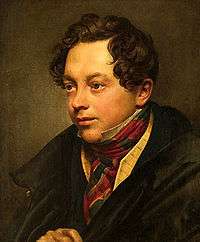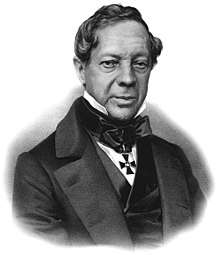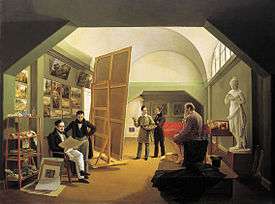Pyotr Basin
Pyotr Vasilievich Basin (Russian: Пётр Васильевич Басин; 1793, Saint Petersburg - 1877, Saint Petersburg) was a Russian religious, history and portrait painter (since 1830), professor (since 1836). Grandfather of the historian N. Grushke.
Pyotr Basin | |
|---|---|
Пётр Васильевич Басин | |
 Pyotr Basin, by Orest Kiprensky (1828) | |
| Born | June 25, 1793 |
| Died | July 16, 1877 (aged 84) |
| Education | Member Academy of Arts (1830) |
| Alma mater | Imperial Academy of Arts (1818) |
| Known for | Painting |
| Awards | |
Biography
Youth and education in Italy
Basin Peter Vasilievich was born in 1793 in St. Petersburg. He has served in an expedition on the state revenues of the Ministry of Finance. Since 1811 he attended the drawing classes of the Academy of Arts as an auditor; in 1813 he entered the Academy as a student, mastered the artistic skill under the guidance of Professor V.K. Shebuyev. In 1818 he had received a "large gold medal" for a depiction of a "Christ expeling merchants out of the temple" and the right to retire abroad by means of Academy's funds.
He studied at the Imperial Academy of Arts under Vasily Shebuyev.[1] After graduating, he spent the next eleven years in Rome on a fellowship, which he was given for his painting of Christ driving the money changers from the Temple.[2] While there, he created almost 100 works.
Upon his return to Saint Petersburg in 1830, he was made an Academician for his portrayal of Socrates saving Alcibiades.[1] The painting itself required some saving, as the ship carrying it from Rome was wrecked, causing water damage, and it had to be reconstructed on its arrival.[2] After that, he began teaching and was appointed a Professor in 1836,[1] a position he held until 1869 when he became a Professor Emeritus and State Councilor.[2] He lost his eyesight in 1870.[3]
During the time he was a Professor, he created numerous portraits and allegorical scenes for the restoration of the Winter Palace after the disastrous fire in 1837,[3] but his religious works are the most familiar. They include forty paintings and icons for Saint Isaac's Cathedral.
He is mentioned in a story ("The Artist") by Taras Shevchenko. His best-known student was Nikolai Ge.
Basin spent 11 years in Rome, he had copied the works of Raphael ("The Apostle Peter's Excerpt from the Dungeon", "The Bolsena Miracle", "Apollo and Muse" from the papal palace, and the "Sibyls" from the Church of Santa Maria della Pace) and Domenichino ("The Accomplishment of Saint Jerome", frescoes with the life of St. Nilus from Grottaferrata). In the same period, a number of Basin's earliest original works were created both for academic mythological subjects (Faun Marsii teaches the Olympia boy to play the pipe, Faun and Nymph) and to a more realistic genre topics (The Italian Robber, Earthquake in Rocca di Papa, near Rome ","Washerwomen hanging clothes "), as well as portraits of S.F. Shchedrin and family members of Colonel Lorer.
The Russian period of creativity
In 1826-1828 Basin created the painting "Socrates at the Battle of Potidee defends Alcibiades." After the successful display of this painting in Rome, the painting was sent by sea to St. Petersburg, but the ship was wrecked and the canvas was damaged. Upon returning to his homeland (where he was summoned by Emperor Nicholas I to work on the construction of St. Isaac's Cathedral) Basin restored the painting and presented it to the Academy of Arts. In 1830, Basin received for the work the title of an academician, and shortly after that began teaching, thus receiving the title of professor of the second degree in 1836, in 1846 - a professor of the first degree, and in 1856 - a distinguished professor in portrait and historical painting. Since 1859 he taught in the field class. In 1869, at the rank of a valid state councilor, he left the department because of a progressive eye disease.

Although Basin has worked a lot as a portraitist, he gained fame through monumental works in churches and secular public buildings, including the St. Isaac's Cathedral, for which he had made up to forty images and paintings of religious content, from all the artists who worked in the cathedral, thus he made the largest amount murals. Basin finished the sketches of Bryullov on the plafond of the cathedral's main dome, created the composition "Sermon on the Mount" over the southern doors, "Judas's Judgment" and "Carrying the Cross" on the central attic (in the same place he wrote "Se man" and "Flagging" for Brullov) pridely communication. Alexander Nevsky and St. Catherine. In the Kazan Cathedral Basin wrote "Introduction to the Temple." In the church of the Academy of Arts he created the altarpiece "The Descent of the Holy Spirit on the Apostles" (which Russian Biographical Dictionary defines as "the best work of the artist") and several images for the iconostases, in the library of the Academy - a plafond. For the Church of the Winter Palace Basin he wrote the work titled "Resurrection of Christ", for the Field Marshal's Hall he created portraits of Kutuzov and Dibich, for the Pompeian Hall he painted mythological figures. The works of Basin were used in decorations of cathedrals in Peterhof and Tiflis. Basin's paintings were included in the collections of the Academy of Arts (primarily the work of the Roman period), the Museum of Emperor Alexander III, the Moscow Public Museum. At the end of his life, in the 1860s, Basin created cardboard paintings for the Moscow Cathedral of Christ the Savior, but he himself could not embody them into the church because of the deterioration of his vision, and the paintings on the basis of sketches were performed by N.A. Koshelev.
Basin's activity was not limited to creative work and teaching. He repeatedly acted as an expert, in particular, with the purchase of the collection of Princess Trubetskaya and works from the collection of the Netherlands King Willem II for the Winter Palace and the purchase of a private sculptural collection of the Rector V. I. Demut-Malinovsky for the Academy of Arts. Basin made efforts to preserve the monuments of Russian architecture, including the preservation of twelve individual roofs on the building of the Twelve Colleges, which were planned to be replaced by one. He also translated from Italian to Russian a brief anatomy course for the painters of J. Del Medico. The artist died in 1877. Buried in St. Petersburg at the Novodevichye Cemetery.[4]
Famous students
- Fedor Chumakov
- Nikolai Ge
- Konstantin Moldavsky

Works
- "Susanna, caught by the elders in the bath" (1822. Oil on canvas 102.5 x 76.5 cm. The State Russian Museum)
- "Faun Marsii teaches the young man Olympia play the pipe" (1821, canvas, oil 185 x 139.5 cm. The State Russian Museum)
- "Earthquake in Rocca di Papa, near Rome" (1830. Oil on canvas 84 x 99 cm. The State Russian Museum)
- "Attic building of the Academy of Arts" (1831. Oil on canvas 63.5 x 80.2 cm. The State Tretyakov Gallery)
- "Woman with a raised hand" (1843. The State Tretyakov Gallery)
- "Portrait of Olga Vladimirovna Basina, the Artist's Wife" (1830s State Russian Museum)
- "Pyramidal poplars" (1820s State Russian Museum)
References
- "Басин, Петр Васильевич". Brockhaus and Efron Encyclopedic Dictionary: In 86 Volumes (82 Volumes and 4 Additional Volumes). St. Petersburg. 1890–1907.
- Русская живопись (Russian painting): Biography
- RusArtNet: Biography
- Whole Petersburg for 1914, address and reference book of the St-Petersburg city. Tovarishestvo. 1914. ISBN 5-94030-052-9.
External links
![]()
.jpg)